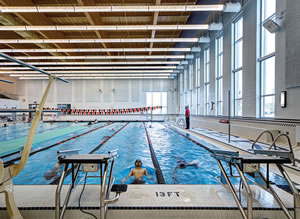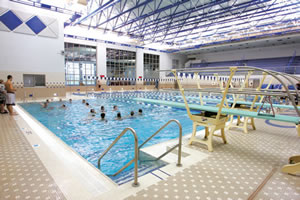What's Cool in Pools
- By John Davids, Bill Robertson
- 10/01/14

PHOTOS COURTESY OF FANNING HOWEY
Back in the 1970s, a significant debate occurred about the proper depth for diving wells in high school pools. At the time, some state codes required a depth of just 10 or 11 feet. In an effort to save money on construction costs, many educational Communities built pools exactly to code. But just a decade or so later, codes in many states changed to require diving wells To be at least 12 feet or deeper. The communities who built the shallower diving wells were forced to renovate their pools. The owners who spent more to construct wells of at least 13 Feet ended up saving money in the long run.
This is one extreme example of the benefits of long-range thinking in pool planning and design. There are many new trends in high school pools that require owners to evaluate short-term savings and long-term value. In each case, there is no right answer. Every owner must ultimately decide what is best for the students, athletes and community.
CHOOSING A POOL THAT FITS
The most basic decision you will need to make is the size of your pool. The standard high school pool is 25 yards with six to eight lanes. The National Federation of State High School Associations recommends eight lanes as a minimum. Obviously, the number of lanes has a significant impact on the cost to build the pool. For swim teams of 35 students or below, a six-lane pool works well. However, once the team gets above 35 swimmers, an eight-lane pool is recommended. Two extra lanes mean shorter swim meets and faster practices. This allows students to spend less time in the pool and more time at home, focusing on their studies.
Lane width is another variable to consider. Anyone who has ever swum laps in a six-foot-wide lane knows that space is at a premium. At the K-12 level, most pools have lanes ranging from six feet to nine feet, with the majority being seven feet. Again, the issue is cost versus functionality. Wider lanes are better, both from a safety and comfort standpoint. Seven-foot lanes are often a good compromise. If you do build a six-lane pool with six-foot-wide lanes, you will not comply with the National Federation of State High School Associations guidelines.
PLASTER VS. TILE
Finishes are one of the most expensive items related to pool construction and pool maintenance. While there are many variations, the three main options, in ascending order of cost, are paint, plaster and tile. The majority of K-12 pools in the country are plaster, which is approximately $75,000 less expensive than tile for a new 25-yard pool. However, it is important to consider long-term operating and maintenance costs when making your selection.
Tile pools require less maintenance over the long-term. Internal maintenance personnel typically have the ability to re-grout a tile pool, if necessary. In addition, many pool consultants now require a 30-year or lifetime warranty on grout for tile pools, thus eliminating that potential expense.
A plaster pool usually needs to be refinished every 10 years or so. Because of the intricate nature of the work, you must hire an outside contractor, who will charge around $30,000 for a standard 25-yard pool. When you factor in the maintenance costs of re-finishing a plaster pool, you find that a tile pool actually costs less over the long term. However, many communities choose plaster due to extra first cost of a tile pool.

PHOTOS COURTESY OF FANNING HOWEY
If you do select a plaster pool, please be aware of the potential pitfalls during the resurfacing efforts. An inexperienced contractor will sometimes try to apply a new layer of plaster on top of the existing finish. This approach will shorten the pool length by up to an inch and result in your venue losing certification for competitive events. When resurfacing, make sure that your contractor adheres to the strict measurements of the existing pool footprint.
WOOD FINISHES AND LIGHTING
New techniques in pool finishes and lighting are providing a better swim environment and dramatically lowering long-term maintenance costs. One such option is Glulam wood beams, which is an engineered wood product that resists corrosion better than the painted steel ceiling of a typical pool. The use of Glulam or similar products eliminates the need to periodically strip and repaint the steel beams on the ceiling, a process that involves draining the entire pool and erecting scaffolding.
Light tubes also provide an exciting alternative to traditional pool systems. In the past, lighting could only be located above the pool deck, to allow maintenance personnel to change the bulbs. This left the lighting at the water’s surface very dim, sometimes a third of what you would find at the pool deck. With a light tube system, a long spectral tube spans the width of the pool. The lights are inserted into the tubes from openings above the pool deck. The lighting runs the length of the tube and is diffused, providing the optimal number of foot candles at the water’s surface.

PHOTOS COURTESY OF FANNING HOWEY
INVESTING IN TECHNOLOGY
Investing in technology will make a big difference for your pool facility. Many swim programs use video equipment and monitors to record and display swimmers during practice. The coach is then able to discuss proper techniques and provide feedback in real time. Starting blocks connected to a timing system are also useful in helping swimmers reduce their start times.
When it comes to pool design, the choices are seemingly endless. In the end, it is important to remember that the pool is, first and foremost, an extension of the educational process. With that thought guiding your decision-making, you will do no wrong.
This article originally appeared in the issue of .